Valentina Doushkina, Qioptiq Polymer Inc.
There is currently a soaring demand for
high-performance optics and optical systems applications in the fields of optometry,
biomedicine, microscopy, and a number of related scientific and industrial fields.
Due to advances in the microelectronics and semiconductor industries,
the pixel size of optical sensors is decreasing to less than 2 x 2 µm, placing high
demands on optical performance. At the same time, miniature cameras for surgical,
diagnostic and other biomedical applications, coupled with fiber optics, place even
higher demands on image resolution; the result is complex, bulky multi-element glass
optical systems. However, improvements in polymer and integrated hybrid glass-polymer
optical systems and components offer many efficient and compact solutions to meet
these demands, while at the same time significantly reducing cost, weight and complexity
of such optical systems.
Polymer and integrated hybrid glass-polymer optics can provide
practical and economic applications for these technologies and markets. For example,
new and smaller endoscopic systems are emerging for clinical use, creating a demand
for low-cost, high-performance and high-volume production optics delivered in a
compact package to support them. The versatility and design freedom of polymer and
hybrid glass-polymer optics, compared to multilens glass assemblies, provide many
advantages. They significantly lower manufacturing costs while offering high optical
performance, a wide field of view, a low f number and, in the case of hybrid optics,
thermal stability. Both types of optics provide solutions not possible in the past
and help bring the products and new technology to the broad consumer market.1
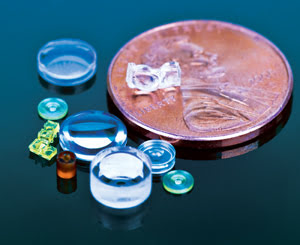 Optical solutions that are based on polymer and hybrid glass-polymer
components and systems can be desirable for multiple markets and/or practical applications.
These systems can be used in specific applications, such as imaging fast lenses
with a low f number for megapixel cameras used as C-mount lenses in applications
requiring high image quality and high resolution; for robotics and machine vision
for high-resolution line-scan applications, industrial inspection and document scanning;
and for telecentric lenses for noncontact optical metrology solutions requiring
a high degree of accuracy and resolution.
Optical solutions that are based on polymer and hybrid glass-polymer
components and systems can be desirable for multiple markets and/or practical applications.
These systems can be used in specific applications, such as imaging fast lenses
with a low f number for megapixel cameras used as C-mount lenses in applications
requiring high image quality and high resolution; for robotics and machine vision
for high-resolution line-scan applications, industrial inspection and document scanning;
and for telecentric lenses for noncontact optical metrology solutions requiring
a high degree of accuracy and resolution.
Micro-optics applications, markets, solutions
“Recent advances in the fields of optometry, medicine, biomedicine
and neurology for surgical and diagnostic applications have put optics manufacturers
into situations where they have reached their manufacturing limits or have gone
beyond the range of their current capabilities,” Doushkina said. Micro-optics
with geometry measured in tenths and low hundredths of microns have been successfully
manufactured on supporting substrates. However, producing an optical system containing
a number of micro-optical stand-alone components and having them aligned, assembled
and sealed present a significant manufacturing challenge – one requiring a
different approach and design philosophy to successfully meet the system and product
requirements.
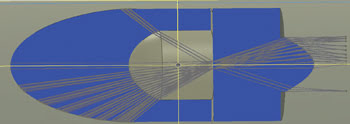
Figure 1. Polymer optics can be used in miniature endoscope cameras,
and integration of the optics and mechanical design can establish levels of performance
not achievable with prior technologies. Images courtesy of Qioptiq Polymer Inc.
A miniature endoscope camera, shown in Figure 1, is one of multiple
examples where polymer optics has enabled the integration of optical and mechanical
design, breaking the limits of prior technology. The result is high resolution and
stable performance over the broadband spectral range with the high light-gathering
power of the fast lens system. Diffraction-limited performance is shown in Figure
2, where the Airy disk encircles the geometric aberrations over the entire wide
field of view.
One matrix defining the resolution of an optical system can be
specified in terms of the finest detail that the system can image. This property
is defined by the modulation transfer function (MTF). The following is a common
definition of MTF:
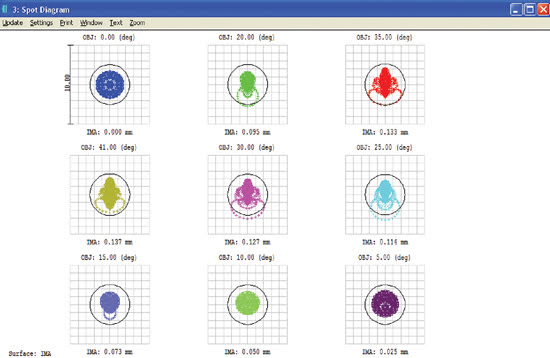
Figure 2. This diagram shows diffraction-limited performance, where the Airy disk encircles
the geometrical aberrations over the entire wide field of view and the broad spectral
range.
If an object with sinusoidally varying brightness I and a frequency
of lp (line pairs) per mm is imaged through the optical system, the modulation of
the object (Mobj) is defined as follows: Mobj = (Imax − Imin)/(Imax + Imin),
where Imax is the maximum intensity and Imin is the minimum intensity of the sine
modulation.
The image is characterized in a similar manner: The modulation
of the image (Mimg) is defined as Mimg = (Imax − Imin)/(Imax + Imin). Therefore,
the MTF is the ratio of the modulation of the image to that of the object: MTF =
Mimg / Mobj. The limiting resolution of the system is defined by the frequency lp/mm
at which the MTF falls below a minimum detectable level (typically 5 percent of
MTF).
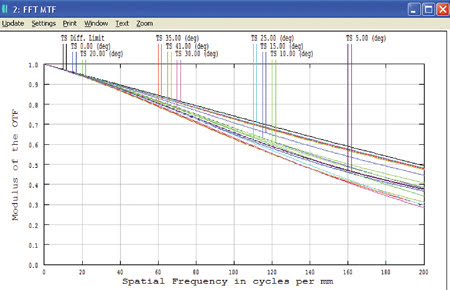
Figure 3. A modulation transfer function that
almost reaches the diffraction limit, even at the high frequencies of 200 line pairs
per millimeter, is suitable for use with modern megapixel sensors of 2 x 2 μm,
and with a smaller single-pixel size.
Shown in Figure 3 is a highly resolved system with an MTF function
that nearly reaches the diffraction limits, even at high frequencies of 200 lp/mm;
it is suitable for use with both modern megapixel sensors and the smaller single-pixel
size. The pixel size can be derived from the Nyquist frequency, also called the
Nyquist limit:
1
F (Nyqyust) = ----------------
2* PixelSize
Thus, with an average of 40 percent MTF at 200 line pairs per
millimeter, the designed lens is highly compatible with a sensor of 2 x 2-µm pixel
size, and the resolution of the image is “pixel-size limited,” which
meets the demands of the latest state-of-the-art megapixel sensors.
The significant advantage of the optical system presented, when
it is integrated with the mechanical housing, is that the tolerances of the optomechanical
housing are integrated into the optical design, resulting in precise mounting and
assembly of the only two components. Compared to a conventional approach, where
the tolerance budget is shared between the optical and the mechanical components,
the optical tolerances are more relaxed.2 This design philosophy will not be possible
with glass optics. Monte Carlo statistical tolerance analysis has confirmed the
feasibility of the design and of a single drop-in assembly step with no alignment
needed.
The sample design presented in Figure 3 can be used in many other
optical imaging applications (where the temperature range is not broad), offering
the features of (1) high image resolution, (2) compact packaging, (3) low weight,
(4) high repeatability of the process and (5) low manufacturing cost.
Hybrid glass-polymer systems
There are multiple markets and applications in which the thermal
stability of the optical system within a broad thermal range is necessarily a factor
for optical device/system functionality. A disadvantage of polymer stand-alone optics
is the lack of thermal stability due to the high coefficient of thermal expansion.
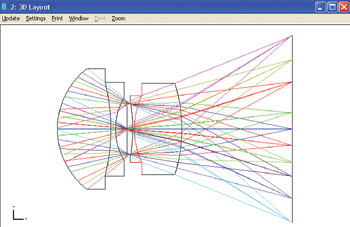
Figure 4. Thermal
stability and low manufacturing cost are great advantages of hybrids, which have
the thermal stability of glass and the low manufacturing cost of polymer optics.
However, when polymer and glass optics are integrated into a hybrid
glass-polymer solution, this limitation can be resolved. One of the great advantages
of hybrid systems is that they maintain the thermal stability of glass while offering
the relatively low manufacturing cost of polymer optics.1 When the glass component
carries the optical power, and a thin layer of the aspherized polymer component
is used to correct for aberrations, the thermal behavior of the hybrid is as stable
as that of glass optics – or even better, since the dn/dt, the temperature
coefficient of refractive index (for a given wavelength), is negative for polymers
and positive for the optical glass.
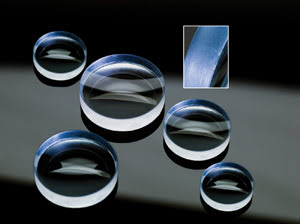
Figure 5. Glass-polymer hybrid optics offer multiple advantages in
terms of efficiency and compactness, and also can reduce the cost, weight and complexity
of optical systems.
Additionally, the low weight and compact packaging of a hybrid
system (resulting in a minimal number of optical components) are very desirable.
An example of high-performance hybrid optics is shown in Figure 4. The system can
be successfully used in the automotive industry, for example, to track lane position
or to recognize objects as part of a warning system.
Considering the wide field of view offered by the system, its
high resolution and image stability over a broad temperature range and wide spectrum,
it offers excellent adaptability for driverless driving technology. This technology
is finding its way into consumer vehicles, and it answers a product demand for low-cost,
high-performance and high-production-volume optics in a compact package. Variations
of this technology can also be used for robotics and machine sensing for high-resolution
line-scan applications, industrial inspection and document scanning.
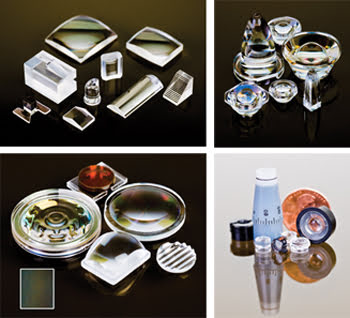
Figure 6. Qioptiq Polymer Inc. produces polymer prisms (top left), polymer total internal
reflection optics (top right), polymer diffractive optics (bottom left), and polymer
collimating lenses and housings (bottom right).
Meet the author
Valentina Doushkina is director of engineering at Qioptiq Polymer
Inc. in La Verne, Calif., and the lead instructor at the University of California
Irvine, Extension. She also is president of the Optical Society of Southern California;
e-mail: [email protected].
References
1. V. Doushkina (2010, Vol. 7788). Innovative hybrid optics: Combining
the thermal stability of glass with low manufacturing cost of polymers. Proc SPIE,
p. 778809.
2. V. Doushkina, E. Fleming (2009, Vol. 7424). Optical and mechanical
design advantages using polymer optics. Proc SPIE, p. 74240Q.